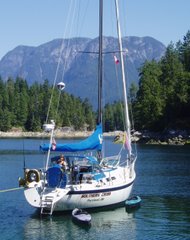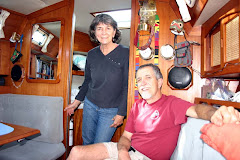What a treat to have a daysail instead of an overnighter to our next destination. We had good wind and sailed out of Fakarava's north pass with very little current. Within a mile or so we could already see the palm-lined motus at Toau. As we approached Otugi Pass, the ebb current was setting up standing waves against the east wind, but we were able to avoid most of the current by hugging the southern edge of the pass. We only had to fight 3.5 knots of current, and with a quartering breeze and a little help from the diesel were soon through the pass. We turned left and headed to one of the 2 recommended anchorages at Toau, near a small reef and in the shelter of a huge palm grove. Ah, looks like we have the entire lagoon to ourselves! After anchoring and having lunch, we took a short nap, but were awakened by the sound of a pair of small diesel engines. We looked out the companionway to see the catamaran flotilla steaming by. We had expected they would go all the way to Anse Amyot at the other end of the atoll, but here they were. No problem, there is plenty of room here.
The next morning, we dinghied back out to the pass, but there was already a slight ebb current, so we snorkeled in the lagoon instead.



This is a very "sharky" lagoon, meaning lots of them and they are not shy. We got a bit uncomfortable as several sharks persisted in entering our "personal space."
At mid-day, we decided to move to an undesignated anchorage between the two passes, to join
Blue Rodeo and
Gato Go, who had just arrived from Fakarava. There was a sturdy-looking mooring, so we picked that up instead of trying to anchor amidst the towering coral bommies on the bottom. Later,
Island Bound joined us. We are among an avid group of divers, and are the only boat in the anchorage without a scuba compressor!

The next morning dawned sunny and calm. Based on our snorkel, we thought we should head out early to snorkel the small northern pass. But the flood current lasted until nearly 10:30, leaving us time to make numerous drifts from the ocean through the pass into the lagoon. The current was a bit tricky, and we had to be careful not to be set into the breakers lining the northern edge of the pass. We saw numerous sharks and a few napoleons, and a spotted eagle ray, but there was not very good coral here. The best area was a large curving ledge with several arches and caves, and after doing several drifts, Vicki and I anchored over it so we could observe all the action for a longer period.
 Leysin
Leysin arrived in the afternoon, but their dinghy engine was not running, so we took them out to the main (Otugi) pass the next morning. The coral was not very good in this pass either, but the terrain was very interesting - numerous ridges and canyons grooved the bottom, leading to a large "amphitheater" with a sandy bottom and surrounded by small cliffs. This area was teeming with gray and silvertip sharks, and there were a number of whitetips "sleeping" in the sand. Twice we saw a 3-meter long lemon shark, the first we had ever seen.
Blue Rodeo and
Gato Go joined us later, and saw a giant manta. This area would make a nice dive site, as long as you kept a careful eye on your direction of drift. The slack doesn't seem to last more than a few minutes here.
After we were done snorkeling, the wind veered to the south and the anchorage got bouncy.
Blue Rodeo and
Gato Go decided to head for Anse Amyot, but we weren't ready for open water yet, so we decided to double back to the southeastern corner of the lagoon, and
Leysin followed us over.

This turned out to be a lovely anchorage, with a nice beach to walk, and a large coconut grove where teams of men were husking nuts and burning dead fronds.




After a nice afternoon of snorkeling and walking,
Leysin invited us over for poisson cru and grilled parrotfish, from fish they had been given by the locals. We got back to our boat just in time to avoid a series of heavy downpours that lasted all night.
This was a place we could have easily stayed a week, had we not been on a schedule. But the next morning dawned clear with a fair wind, so we decided to sail on to Anse Amyot, probably our last stop in the Tuamotus before making the 200-mile crossing to Tahiti.





 This is a very "sharky" lagoon, meaning lots of them and they are not shy. We got a bit uncomfortable as several sharks persisted in entering our "personal space."
At mid-day, we decided to move to an undesignated anchorage between the two passes, to join Blue Rodeo and Gato Go, who had just arrived from Fakarava. There was a sturdy-looking mooring, so we picked that up instead of trying to anchor amidst the towering coral bommies on the bottom. Later, Island Bound joined us. We are among an avid group of divers, and are the only boat in the anchorage without a scuba compressor!
This is a very "sharky" lagoon, meaning lots of them and they are not shy. We got a bit uncomfortable as several sharks persisted in entering our "personal space."
At mid-day, we decided to move to an undesignated anchorage between the two passes, to join Blue Rodeo and Gato Go, who had just arrived from Fakarava. There was a sturdy-looking mooring, so we picked that up instead of trying to anchor amidst the towering coral bommies on the bottom. Later, Island Bound joined us. We are among an avid group of divers, and are the only boat in the anchorage without a scuba compressor!
 The next morning dawned sunny and calm. Based on our snorkel, we thought we should head out early to snorkel the small northern pass. But the flood current lasted until nearly 10:30, leaving us time to make numerous drifts from the ocean through the pass into the lagoon. The current was a bit tricky, and we had to be careful not to be set into the breakers lining the northern edge of the pass. We saw numerous sharks and a few napoleons, and a spotted eagle ray, but there was not very good coral here. The best area was a large curving ledge with several arches and caves, and after doing several drifts, Vicki and I anchored over it so we could observe all the action for a longer period.
The next morning dawned sunny and calm. Based on our snorkel, we thought we should head out early to snorkel the small northern pass. But the flood current lasted until nearly 10:30, leaving us time to make numerous drifts from the ocean through the pass into the lagoon. The current was a bit tricky, and we had to be careful not to be set into the breakers lining the northern edge of the pass. We saw numerous sharks and a few napoleons, and a spotted eagle ray, but there was not very good coral here. The best area was a large curving ledge with several arches and caves, and after doing several drifts, Vicki and I anchored over it so we could observe all the action for a longer period.
 Leysin arrived in the afternoon, but their dinghy engine was not running, so we took them out to the main (Otugi) pass the next morning. The coral was not very good in this pass either, but the terrain was very interesting - numerous ridges and canyons grooved the bottom, leading to a large "amphitheater" with a sandy bottom and surrounded by small cliffs. This area was teeming with gray and silvertip sharks, and there were a number of whitetips "sleeping" in the sand. Twice we saw a 3-meter long lemon shark, the first we had ever seen. Blue Rodeo and Gato Go joined us later, and saw a giant manta. This area would make a nice dive site, as long as you kept a careful eye on your direction of drift. The slack doesn't seem to last more than a few minutes here.
After we were done snorkeling, the wind veered to the south and the anchorage got bouncy. Blue Rodeo and Gato Go decided to head for Anse Amyot, but we weren't ready for open water yet, so we decided to double back to the southeastern corner of the lagoon, and Leysin followed us over.
Leysin arrived in the afternoon, but their dinghy engine was not running, so we took them out to the main (Otugi) pass the next morning. The coral was not very good in this pass either, but the terrain was very interesting - numerous ridges and canyons grooved the bottom, leading to a large "amphitheater" with a sandy bottom and surrounded by small cliffs. This area was teeming with gray and silvertip sharks, and there were a number of whitetips "sleeping" in the sand. Twice we saw a 3-meter long lemon shark, the first we had ever seen. Blue Rodeo and Gato Go joined us later, and saw a giant manta. This area would make a nice dive site, as long as you kept a careful eye on your direction of drift. The slack doesn't seem to last more than a few minutes here.
After we were done snorkeling, the wind veered to the south and the anchorage got bouncy. Blue Rodeo and Gato Go decided to head for Anse Amyot, but we weren't ready for open water yet, so we decided to double back to the southeastern corner of the lagoon, and Leysin followed us over.
 This turned out to be a lovely anchorage, with a nice beach to walk, and a large coconut grove where teams of men were husking nuts and burning dead fronds.
This turned out to be a lovely anchorage, with a nice beach to walk, and a large coconut grove where teams of men were husking nuts and burning dead fronds.



 After a nice afternoon of snorkeling and walking, Leysin invited us over for poisson cru and grilled parrotfish, from fish they had been given by the locals. We got back to our boat just in time to avoid a series of heavy downpours that lasted all night.
This was a place we could have easily stayed a week, had we not been on a schedule. But the next morning dawned clear with a fair wind, so we decided to sail on to Anse Amyot, probably our last stop in the Tuamotus before making the 200-mile crossing to Tahiti.
After a nice afternoon of snorkeling and walking, Leysin invited us over for poisson cru and grilled parrotfish, from fish they had been given by the locals. We got back to our boat just in time to avoid a series of heavy downpours that lasted all night.
This was a place we could have easily stayed a week, had we not been on a schedule. But the next morning dawned clear with a fair wind, so we decided to sail on to Anse Amyot, probably our last stop in the Tuamotus before making the 200-mile crossing to Tahiti.





No comments:
Post a Comment